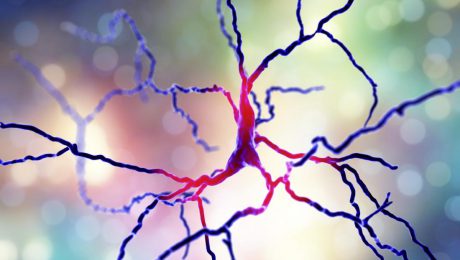New strategy to treat Parkinson’s disease
Northwestern Medicine scientists have used patient-derived neurons to develop and test a new strategy to treat Parkinson’s disease by mitigating the effects of harmful genetic mutations, as detailed in a study published today (Oct. 16) in Science Translational Medicine.
Some experimental treatments for genetic disorders target mutated proteins or enzymes, but this study, led by Dr. Dimitri Krainc, took a different approach. Instead of trying to fix broken enzymes, the scientists amplified healthy ones, an approach that successfully alleviated symptoms of Parkinson’s disease (PD) in human brain cells and in mouse models.
“This study highlights wild-type GCase activation as a potential therapeutic target for multiple forms of Parkinson’s disease,” said Krainc, who is chair of neurology and director of the Center for Neurogenetics at Northwestern University Feinberg School of Medicine
Parkinson’s is the second-most common neurodegenerative disorder, predominately affecting neurons in an area of the brain called the substantia nigra. These neurons are responsible for producing dopamine – a chemical messenger used to transmit signals throughout the brain — and for relaying messages that plan and control body movement.
Mutations in the gene GBA1 represent the most common genetic risk factor for PD, according to the study, and GBA1 codes for an enzyme called glucocerebrosidase (GCase) that is important for neuronal function. PD-associated mutations can disable GBA1 and produce misshapen GCase enzymes, which contribute to an accumulation of toxic proteins in dopamine-producing neurons.
As this neuronal population dies, patients experience symptoms such as tremors and slowness of movement. While some medications can offer relief for these symptoms, there is no treatment that can stop or slow the disease.
According to Krainc, drug development for patients with GBA1-linked Parkinson’s has largely focused on stabilizing mutated GCase and limiting its harmful effects. However, these treatments would be effective only in a few types of PD.
“Instead, activating wild-type GCase may be more relevant for multiple forms of PD that exhibit reduced activity of wild-type GCase,” Krainc said.
In the current study, scientists developed a new series of chemical activators that stabilized and amplified normal GCase. The activator, a small molecule that binds to GCase, improved PD-related cellular dysfunction in patient derived neurons.
Importantly, these activators worked in several varieties of PD, showing this strategy could work for a wide range of patients, Krainc said.
“Our work points to the potential for modulating wild-type GCase activity and protein levels in both genetic and idiopathic forms of PD and highlights the importance of personalized or precision neurology in development of novel therapies,” he said.
A 2017 study led by Krainc and published in Science found that some of the key pathological features of PD were only seen in human neurons and not in mouse models, further emphasizing the value of patient-derived neurons for drug development in Parkinson’s disease.
“It will be important to examine human neurons to test any candidate therapeutic interventions that target midbrain dopaminergic neurons in PD,” Krainc said.
Lena F Burbulla, Sohee Jeon, Jianbin Zheng, Pingping Song, Richard B Silverman,
Dimitri Krainc.
A modulator of wild-type glucocerebrosidase improves pathogenic phenotypes in
dopaminergic neuronal models of Parkinson’s disease.
Science Translational Medicine, 16 Oct 2019, Vol. 11, Issue 514.
- Published in News
Rare diseases: Over 300 million patients affected worldwide
Rare diseases represent a global problem. Until now, the lack of data made it difficult to estimate their prevalence. Created and coordinated by Inserm, the Orphanet database, which contains the largest amount of epidemiological data on these diseases taken from the scientific literature, has made it possible to obtain a global estimate. Under the coordination of Inserm US14 Director Ana Rath, these data have shown that more than 300 million people worldwide are currently living with a rare disease. The study, published in the European Journal of Human Genetics, is the first to analyze the available data on rare diseases with such precision.
Systemic sclerosis, polycythemia vera and Marfan syndrome… These are obscure conditions, which are still largely unknown by the general public and differ broadly in their clinical expression. They do have one thing in common: they are very rare.
According to the European definition, a disease is considered rare when it affects fewer than 5 in 10,000 people. Few studies have been performed by the scientific community, and there is a lack of health professional expertise and of suitable treatments. This means that the thousands of rare diseases identified over the years cause immense suffering to many patients and their families, throughout the world.
The few epidemiological studies published on the subject so far rarely use general population registries. This made it difficult to establish their exact prevalence.
Yet such figures are needed if we are to identify priorities for health and research policy, understand the societal burden of these diseases, adapt the management of patients and, more generally, promote a real public health policy for rare conditions. “Given that little is known about rare diseases, we could be forgiven for thinking that their sufferers are thin on the ground. But when taken together they represent a large proportion of the population. Although rare diseases are individual and specific, what they have in common is their rarity, and the consequences which result from that”, emphasizes Ana Rath, from Inserm US14 (Information and service platform for rare diseases and orphan drugs).
Under her leadership, study author Stéphanie Nguenguan (Inserm US14), and her colleagues, used the Orphanet database to shed light on the issue.
- Published in News
Bed time is the best time to take blood pressure medication
People with high blood pressure who take all their anti-hypertensive medication in one go at bedtime have better controlled blood pressure and a significantly lower risk of death or illness caused by heart or blood vessel problems, compared to those who take their medication in the morning, according to new research.
The Hygia Chronotherapy Trial, which is published in the European Heart Journal [1], is the largest to investigate the effect of the time of day when people take their anti-hypertensive medication on the risk of cardiovascular problems. It randomized 19,084 patients to taking their pills on waking or at bedtime, and it has followed them for the longest length of time – an average of more than six years – during which time the patients’ ambulatory blood pressure was checked over 48 hours at least once a year.
The researchers, who are part of the Hygia Project led by Professor Ramón C. Hermida, Director of the Bioengineering and Chronobiology Labs at the University of Vigo, Spain, found that patients who took their medication at bedtime had nearly half the risk (45% reduction) of dying from or suffering heart attacks, myocardial infarction, stroke, heart failure or requiring a procedure to unblock narrowed arteries (coronary revascularization), compared to patients who took their medication on waking.
The researchers had adjusted their analyses to take account of factors that could affect the results, such as age, sex, type 2 diabetes, kidney disease, smoking and cholesterol levels.
When they looked at individual outcomes, they found that the risk of death from heart or blood vessel problems was reduced by 66%, the risk of myocardial infarction was reduced by 44%, coronary revascularization by 40%, heart failure by 42%, and stroke by 49%.
Prof Hermida said: “Current guidelines on the treatment of hypertension do not mention or recommend any preferred treatment time. Morning ingestion has been the most common recommendation by physicians based on the misleading goal of reducing morning blood pressure levels. However, the Hygia Project has reported previously that average systolic blood pressure when a person is asleep is the most significant and independent indication of cardiovascular disease risk, regardless of blood pressure measurements taken while awake or when visiting a doctor. Furthermore, there are no studies showing that treating hypertension in the morning improves the reduction in the risk of cardiovascular disease.
“The results of this study show that patients who routinely take their anti-hypertensive medication at bedtime, as opposed to when they wake up, have better-controlled blood pressure and, most importantly, a significantly decreased risk of death or illness from heart and blood vessel problems.” [2] [3]
The Hygia Project is composed of a network of 40 primary care centres within the Galician Social Security Health Service in northern Spain. A total of 292 doctors are involved in the project and have been trained in ambulatory blood pressure monitoring, which involves patients wearing a special cuff that records blood pressure at regular intervals throughout the day and night. The Hygia Chronotherapy Trial is unusual in monitoring blood pressure for 48 hours, rather than the more usual 24 hours.
Between 2008 and 2018, 10,614 men and 8,470 women of Caucasian Spanish origin, aged 18 or over, who had been diagnosed with hypertension by means of ambulatory blood pressure monitoring, were recruited to the trial; they had to adhere to a routine of daytime activity and night-time sleep, which means that it is not possible to say if the study findings apply to people working night shifts.
Doctors took the patients’ blood pressure when they joined the study and at each subsequent clinic visit. Ambulatory blood pressure monitoring over a 48-hour period took place after each clinic visit and at least once a year. This gave doctors accurate information on average blood pressures over the 48 hours, including how much blood pressure decreased or ‘dipped’ while the patients were asleep.
During a median (average) of 6.3 years follow-up, 1752 patients died from heart or blood vessel problems, or experienced myocardial infarction, stroke, heart failure or coronary revascularization. Data from ambulatory blood pressure monitoring showed that patients taking their medication at bedtime had significantly lower average blood pressure both at night and during the day, and their blood pressure dipped more at night, when compared with patients taking their medication on waking. A progressive decrease in night-time systolic blood pressure during the follow-up period was the most significant predictor of a reduced risk of cardiovascular disease.
Prof Hermida concluded: “The findings from the Hygia Chronotherapy Trial and those previously reported from the Hygia Project indicate that average blood pressure levels while asleep and night-time blood pressure dipping, but not day-time blood pressure or blood pressure measured in the clinic, are jointly the most significant blood pressure-derived markers of cardiovascular risk. Accordingly, round-the-clock ambulatory blood pressure monitoring should be the recommended way to diagnose true arterial hypertension and to assess the risk of cardiovascular disease. In addition, decreasing the average systolic blood pressure while asleep and increasing the sleep-time relative decline in blood pressure towards more normal dipper blood pressure patterns are both significantly protective, thus constituting a joint novel therapeutic target for reducing cardiovascular risk.”
The Hygia Project is currently investigating what the best blood pressure levels should be while asleep in order to reduce cardiovascular risk most effectively in the THADEUS Trial (Treatment of Hypertension During Sleep). [4]
Limitations of the Hygia Chronotherapy Trial include that it requires validation in other ethnic groups; the question of whether the same results would be seen in shift workers also requires investigation; and patients were not assigned to specific hypertension medication classes or specific lists of medications within each class – their treatment was chosen by their doctors according to current clinical practice.
- “Bedtime hypertension treatment improves cardiovascular risk reduction: the Hygia Chronotherapy Trial”, by Ramón C. Hermida et al. European Heart Journal. doi:10.1093/eurheartj/ehz754
2. Hygia Project, “Asleep blood pressure: significant prognostic marker of vascular risk and therapeutic target for intervention”, by Ramón C. Hermida et al. European Heart Journal, 2018;39:4159-4171, doi:10.1093/eurheartj/ehy475
3. Systolic blood pressure is the pressure in the arteries as the heart contracts to eject blood out into them. Diastolic blood pressure is the pressure in the arteries between heart beats when the cardiac muscles relax.
4. Treatment of Hypertension During Sleep (THADEUS), https://clinicaltrials.gov/ct2/show/NCT03457168
- Published in News, Scientific
Drugs Approved by FDA in 2019
Balversa (erdafitinib); Janssen Oncology; For the treatment of locally advanced or metastatic urothelial carcinoma , Approved April 2019
Bavencio (avelumab) plus Inlyta (axitinib) ; Merck and Pfizer; For the first line treatment of advanced renal cell carcinoma, Approved May 2019
Cyramza (ramucirumab) ; Eli Lilly; For the treatment of hepatocellular carcinoma with elevated alpha-fetoprotein (AFP), Approved May 2019
Herceptin Hylecta (trastuzumab and hyaluronidase-oysk); Halozyme; For the treatment of HER2-overexpressing breast cancer, Approved February 2019
Inrebic (fedratinib); Celgene; For the treatment of myelofibrosis, Approved August 2019
Keytruda (pembrolizumab) ; Merck; For the treatment of recurrent esophageal cancer with PD-L1 expressing tumors , Approved July 2019
Keytruda (pembrolizumab); Merck; previously treated metastatic small cell lung cancer, Approved June 2019
Keytruda (pembrolizumab); Merck; For the treatment of stage III non-small cell lung cancer, Approved April 2019
Keytruda (pembrolizumab); Merck; For the treatment of advanced renal cell carcinoma, Approved April 2019
Keytruda (pembrolizumab) plus Lenvima (lenvatinib); Merck and Eisai; For the treatment of advanced endometrial carcinoma , Approved September 2019
Nubeqa (darolutamide); Bayer; For the treatment of non-metastatic castration-resistant prostate cancer, Approved July 2019
Piqray (alpelisib) ; Novartis; For the treatment of HR+, HER2-negative, PIK3CA-mutated advanced or metastatic breast cancer, Approved May 2019
Polivy (polatuzumab vedotin-piiq) ; Genentech; For the treatment of diffuse large B-cell lymphoma, Approved June 2019
Rozlytrek (entrectinib); Genentech; For the treatment of ROS1-positive non-small cell lung cancer and NTRK Gene Fusion-Positive Solid Tumors, Approved August 2019
Tecentriq (atezolizumab); Genentech/Roche; For the treatment of extensive-stage small cell lung cancer , Approved March 2019
Tecentriq (atezolizumab); Genentech/Roche; For the treatment of triple negative breast cancer, Approved March 2019
Turalio (pexidartinib); Daiichi Sankyo; For the treatment of symptomatic tenosynovial giant cell tumor, Approved August 2019
Venclexta (venetoclax) plus Gazyva (obinutuzumab); Genentech and AbbVie; For the treatment of chronic lymphocytic leukemia or small lymphocytic lymphoma , Approved May 2019
Xpovio (selinexor) ; Karyopharm Therapeutics; For the treatment of adults with relapsed or refractory multiple myeloma , Approved July 2019
- Published in News





